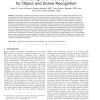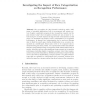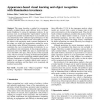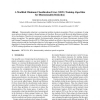111 search results - page 11 / 23 » Discriminant Additive Tangent Spaces for Object Recognition |
PAMI
2010
13 years 5 months ago
2010
—Image category recognition is important to access visual information on the level of objects and scene types. So far, intensity-based descriptors have been widely used for featu...
PAMI
2011
12 years 10 months ago
2011
—We present a discriminative part-based approach for human action recognition from video sequences using motion features. Our model is based on the recently proposed hidden condi...
ISVC
2005
Springer
14 years 26 days ago
2005
Springer
Face recognition is a key biometric technology with a wide range of potential applications both in government and private sectors. Despite considerable progress in face recognition...
ACCV
1998
Springer
13 years 11 months ago
1998
Springer
This paper describes a method for recognizing partially occluded objects under different levels of illumination brightness by using the eigenspace analysis. In our previous work, w...
VLSISP
2002
13 years 7 months ago
2002
Dimensionality reduction is an important problem in pattern recognition. There is a tendency of using more and more features to improve the performance of classifiers. However, not...




